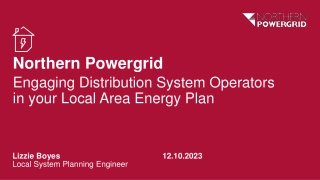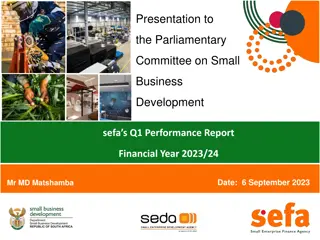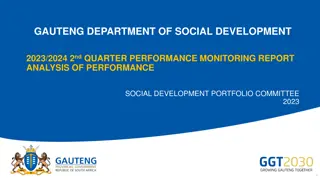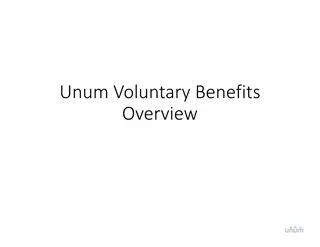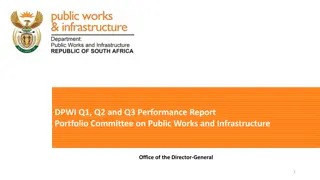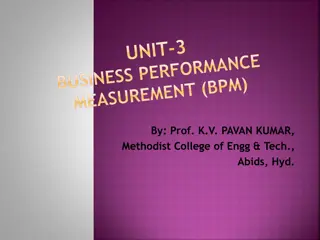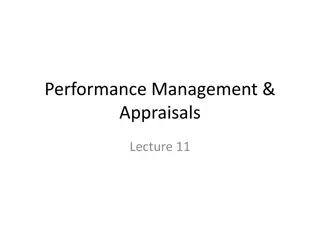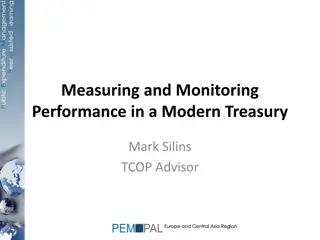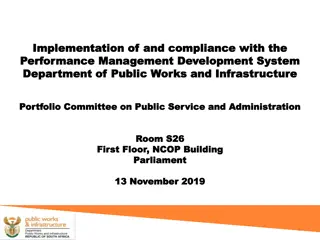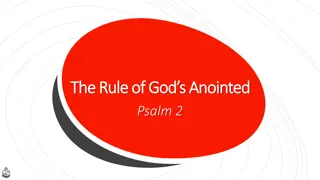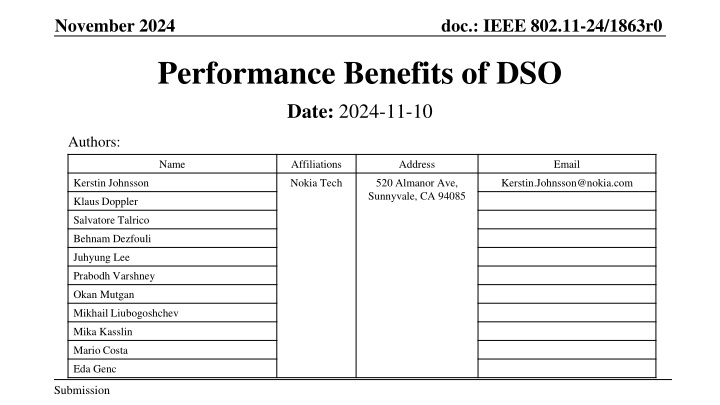
Unlocking Wi-Fi Performance with Dynamic Sub-band Operation (DSO)
"Discover the benefits of Dynamic Sub-band Operation (DSO) in IEEE 802.11-24/1863r0 for optimizing Wi-Fi performance. Learn how DSO addresses bandwidth limitations, synergy with NPCA, and enhances throughput while minimizing latencies."
Download Presentation

Please find below an Image/Link to download the presentation.
The content on the website is provided AS IS for your information and personal use only. It may not be sold, licensed, or shared on other websites without obtaining consent from the author. If you encounter any issues during the download, it is possible that the publisher has removed the file from their server.
You are allowed to download the files provided on this website for personal or commercial use, subject to the condition that they are used lawfully. All files are the property of their respective owners.
The content on the website is provided AS IS for your information and personal use only. It may not be sold, licensed, or shared on other websites without obtaining consent from the author.
E N D
Presentation Transcript
doc.: IEEE 802.11-24/1863r0 November 2024 Performance Benefits of DSO Date: 2024-11-10 Authors: Name Affiliations Address Email Kerstin Johnsson Nokia Tech 520 Almanor Ave, Sunnyvale, CA 94085 Kerstin.Johnsson@nokia.com Klaus Doppler Salvatore Talrico Behnam Dezfouli Juhyung Lee Prabodh Varshney Okan Mutgan Mikhail Liubogoshchev Mika Kasslin Mario Costa Eda Genc Submission
doc.: IEEE 802.11-24/1863r0 Overview Problem statement DSO definition DSO and NPCA synergy DSO performance benefits Straw poll Submission Slide 2
doc.: IEEE 802.11-24/1863r0 Problem Statement 802.11be supports up to 320MHz operating bandwidth However, some non-AP STAs may only support operating bandwidths < 320 MHz (e.g., 160 MHz, 80 MHz, 20 MHz) Since STA s operating BW must include primary channel, BW mismatch between AP and associated non-AP STAs can result in large parts of BSS operating BW going unused in BSS (see figure) Submission Slide 3
doc.: IEEE 802.11-24/1863r0 Dynamic Sub-band Operation (DSO) DSO enables an AP to allocate any available part of its operating bandwidth to associated non-AP STAs DSO has already been proposed in many contributions: 2204 and 0843r1 from SG 1496, 2027r2, 2141r3, 0517, 0783r1, 0949r1, 1244, 1474, 1553, 1564r2, 1587r1, and 1588r1 from TG Contributions generally cover one/both of the following: Pre-negotiation between AP and its associated non-AP STAs of DSO capabilities (turn on/off DSO, sub- bands available for DSO, switching time per sub-band, etc.) DSO trigger (either in a standalone control frame or enabled via existing control frames like MU- RTS/BSRP) along w/ required contents/changes to said frames Proposed spec impacts are minimal, while perf gains can be substantial (see slide 6) Submission Slide 4
doc.: IEEE 802.11-24/1863r0 Synergy with NPCA Non-primary channel access (NPCA) has already been adopted in SFD DSO and NPCA are similar in that they enable AP/non-AP STAs to use other parts of BSS operating BW Together, they address two major limitations on Wi-Fi performance: Inability to use BSS operating BW when primary channel is busy Inability to use BSS operating BW when non-AP STAs have limited operating BW NPCA allows AP/non-AP STAs to temporarily move their primary channel to a different location in the BSS s operating BW when the primary channel is busy DSO is simpler (as primary channel still available to manage procedure) and requires far fewer changes to standard Both are needed to maximize Wi-Fi throughput and minimize latencies Submission Slide 5
doc.: IEEE 802.11-24/1863r0 DSO performance benefits Statistical model of Wi-Fi 4x4 BSS Wi-Fi deployment 160 MHz APs, 40 MHz STAs Reuse 4, i.e., in cluster of 4 APs, each is assigned diff 40 MHz from 160 MHz BW Without DSO, AP/STA must use assigned 40 MHz if/when available With DSO, AP/STA can use any available part of 160 MHz; when non-primary 40MHz used, TXOP reduced by 1/5 to account for switch time STAs per AP = [16, 31, 50] Avg UL/DL traffic per STA = [low, med, high, very high] Blocking range = [1.4R, 2R], where APs are 2R distance apart 3x 1.6x DSO gains increase w/traffic load, reaching ~1.5x-3x throughput gain over baseline depending on blocking range Submission Slide 6
doc.: IEEE 802.11-24/1863r0 Straw Poll 1 As part of 802.11bn, do you agree that it would be beneficial to enable an AP to dynamically assign any part of its operating bandwidth to its associated non-AP STAs regardless of their operating bandwidths? Y/N/A Submission Slide 7
doc.: IEEE 802.11-24/1863r0 Appendix Submission Slide 8
doc.: IEEE 802.11-24/1863r0 Related Straw Polls (1 of 3) 2204r0 (Sindhu Verna, Broadcom) Do you agree to define Dynamic Subband Operation (DSO) in UHR where narrower bandwidth capable non-APs can dynamically on a per-TXOP basis, be allocated resources outside of their current operating bandwidth within the larger bandwidth of an AP? 0843r1 (Liuming Lu, OPPO) Do you support to specify dynamic subband/subchannel operation(DSO) as a mode of operation and a mechanism for the flexible management of DSO mode in UHR? 2027r2 (Vishnu Ratnam, Samsung) 1. Do you agree to allow DSO Sub-band Switch initial control frame to address DSO STAs that are served much later in a TXOP without soliciting ACK/CTS from them? 2. Do you agree to allow an AP to use a follow-up frame to the DSO Sub-band Switch initial control frame to reserve the medium for the time required for the DSO Sub-band switch? 2141r3 (Sindhu Verma, Broadcom) Do you agree to define a mechanism where narrower bandwidth non-APs can dynamically, on a per-TXOP basis, be allocated resources outside of their current operating bandwidth within the larger bandwidth of an AP? 517r0 (Vishnu Ratnam, Samsung) 1. Do you agree to allow DSO Sub-band Switch initial control frame to provide sub-band indication for any DSO STA scheduled to be served within the TXOP? 2. Do you agree to allow DSO Sub-band Switch initial control frame to indicate to an addressed DSO STA, if a response is solicited from the STA? 0783r1 (Chaoming Luo, OPPO) 1. Do you agree that an UHR non-AP STA may solicit dynamic sub-band transmission during the associated AP s TXOP? 2. Do you agree that an UHR non-AP STA may indicate dynamic sub-band transmission during its TXOP? 0949r1 (Seongho Byeon, Samsung) Do you support to define a mechanism in 11bn, enabling resource allocations to non-AP STAs beyond their current operational bandwidth and within the associated AP's BSS bandwidth on a per Broadcast TWT Service Period basis? Submission
doc.: IEEE 802.11-24/1863r0 Related Straw Polls (2 of 3) 1244r0 (Ross Jian Yu, Huawei) 1. Do you agree to include the following into the 11bn SFD? 11bn supports subchannel selective transmission for secondary 160 MHz channel. 2. Do you agree to include the following into the 11bn SFD? 11bn supports subchannel selective transmission when there exists static preamble puncturing. Dynamic preamble puncturing case is TBD 3. Do you agree to include the following into the 11bn SFD? 11bn defines frequency domain aggregation of a 160 MHz HE PPDU and 160 MHz UHR PPDU. 4. Do you agree to include the following into the 11bn SFD? 11bn defines frequency domain aggregation of an 80 MHz HE PPDU, 80 MHz HE PPDU and 160 MHz UHR PPDU. 1553r0 (Gaurang Naik, Qualcomm) 1. Do you support that in the DSO ICF, the AP indicates to a DSO STA to switch to a DSO sub-band Upon reception of the DSO ICF, the DSO STA shall Transition to the DSO sub-band, Transmit the response in the DSO sub-band a SIFS after the end of the DSO ICF And receive frames or be triggered to transmit frames, subject to its spatial stream capabilities and operation mode, in the DSO sub-band (derived from the DSO ICF), a SIFS after the end of the response frame Note: how the STA performs CS check before responding to DSO ICF is TBD 2. Do you agree that if no non-AP STA that is assigned resources in the primary 20 MHz responds to the initial Control frame and there is at least one response on other channels, the AP shall do one of the following: Terminate the frame exchange sequence with all non-AP STAs, or Continue the frame exchange sequence by ensuring that the primary 20 MHz is occupied Whether there are other options is TBD 1564r2 (Liwen Chu, NXP) Do you agree that to allocate resources to a DSO STA in a DSO sub-band, the AP shall initiate the frame exchange sequence with a DSO initial Control frame (ICF)? The BSRP Trigger frame shall be a DSO ICF Whether MU-RTS TF is a DSO ICF or not is TBD the DSO sub-band is indicated with the RU allocation field and whether we have additional signaling indicating that it is DSO TxOP or not is TBD Submission
doc.: IEEE 802.11-24/1863r0 Related Straw Polls (3 of 3) 1244r0 (Ross Jian Yu, Huawei) 1. Do you support that DSO STAs shall have operating bandwidth of 80MHzor above Secondary 80MHz in 160MHz BSS can be a DSO subband Secondary 160MHzin 320MHzBSS can be a DSO subband one default 80MHzsubband in 320MHz BSS can be a DSO subband Whether allow one or more 80MHz subband in 320MHzBSS is TBD Only UHR STAs are involved in DSO ICF/ICR frame exchange and PPDU transmissions that follows it. 2. Do you agree that an AP shall initiate a DSO initial Control frame (ICF) to allocate resources to a DSO STA in a DSO subband? BSRP trigger frame shall be a DSO ICF for DL/UL DSO TXOP. Whether MU-RTS trigger frame is a DSO ICF is TBD RU allocation field in ICF indicates the resource allocation for ICR within the DSO subband Whether an explicit indication to a DSO STA to determine DSO operation is TBD 3. Do you agree that an AP, that supports transmitting intermediate FCS, shall include an intermediate FCS in initial control frame to initiate a DSO TXOP, if needed by at least one scheduled DSO STA? Whether mandatory or optional support for transmitting intermediate FCS is TBD. Note: intermediate FCS may not be needed, if no DSO STAs scheduled in the DSO TXOP requires padding.It is TBD whether an intermediate FCS can be avoided if a MIC is present 1588r0 (Sindhu Verma, Broadcom) Do you agree that: Only 80MHz UHR STAs and 160MHz UHR STAs can be DSO STAs The DSO ICF-ICR exchange and the PPDUs that follows it shall only be between UHR STAs One 80MHz subband in 320MHz BSS can be a DSO subband Whether more than one 80MHz subband can be a DSO subband in 320MHz BSS is TBD Secondary 80MHz in 160MHz BSS can be a DSO subband Secondary 160MHz in 320MHz BSS can be a DSO subband Submission


